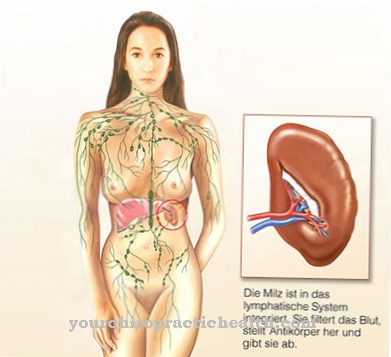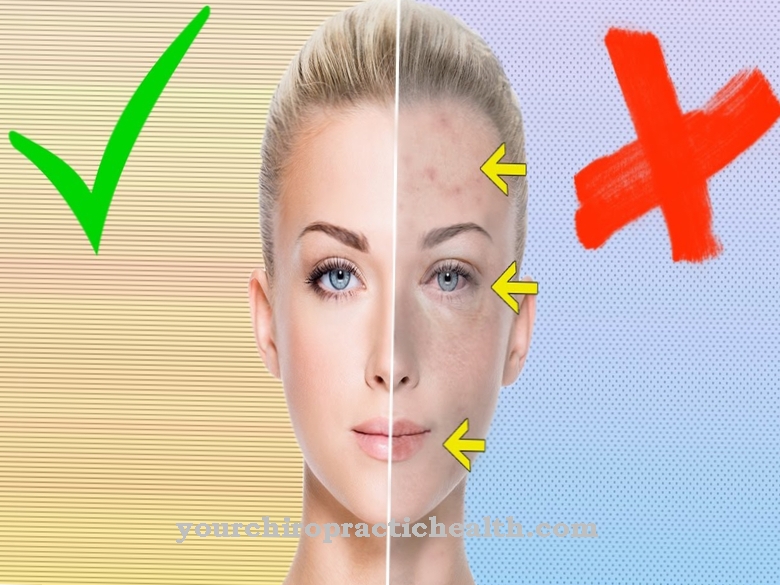The ears are one of the most sensitive human organs. Even the smallest inflammation in the ear area, such as Ear furuncle, can lead to severe pain if not treated early.
What is an ear furuncle?

© LaraFields - stock.adobe.com
Under a Ear furuncle, also known as External otitis circumscripta refers to an inflammatory change in the external auditory canal. There are particularly fine hairs that are barely noticeable to the human eye due to their small size and strength.
Despite their small size, these hairs also have hair roots, which under certain circumstances can reach deep into the skin of the external auditory canal. The last end of the hair that ends in the hair root is called the hair follicle or follicle: a hair piece that is particularly prone to inflammation.
If there is inflammation here, it may grow so strong that it reaches the surface of the skin. And this is exactly what is called the ear furuncle. The further the inflammation progresses, the more the bacteria multiply. The result is that highly infectious pus forms under the skin, which can lead to severe pain for those affected.
causes
The inflammation of the hair follicle that ultimately leads to Ear furuncle are usually caused by a special type of bacteria: the staph family. Many subtypes of this bacterial family belong to the natural skin flora of humans, which not only do not cause diseases or inflammation, but are also of considerable importance for humans as a protective film.
Other types, on the other hand, can cause inflammation such as ear furuncles. Due to their relatively low infectivity, not every contact with staphylococci has to lead to the outbreak of an ear boil. On the contrary: The already mentioned natural skin flora offers effective protection. Only when this skin flora is impaired and the natural protective mechanism is disturbed, ear furuncles can form.
In particular, cleaning the ear canal with cotton swabs promotes the formation of ear furuncles. In addition to removing the skin flora layer, mechanical cleaning also injures the sensitive hairs, which ultimately promotes inflammation.
Symptoms, ailments & signs
An ear furuncle can manifest itself in hot ears and severe pain in the ear. If you carefully feel for the cause of the pain, the pain sensitivity is increased. Severe swelling can be seen in the inner ear. The doctor consulted can also determine redness in the ear. If the ear furuncle has matured sufficiently, it forms a yellow pus focus.
The attending physician can do a visual inspection and a smear test to ensure that the symptoms actually indicate an ear furuncle. Most of the time, but not always, staphylococci are the triggers for an ear boil. If these spread in the body, further symptoms and consequential complaints can occur.
The affected person feels weakened as a whole. He has severe, partially radiating pain in one ear. It can also lead to headaches or body aches. The quality of life is impaired by the severe pain.
The formation of pus in the boil can contaminate the ear if it opens at night. In addition, abscess formation can occur in the case of fuzzy ears. There is a risk of blood poisoning if the causative germs or staphylococci get into the bloodstream. The typical symptoms of a boil in the ear favor such complications.
Therefore, the early symptoms of an ear boil should be clarified and treated by a doctor. A self-treatment of ear boobs is prohibited in view of the complex complaints.
Diagnosis & course
Ear furuncles can be easily determined clinically because of their characteristic appearance. Further diagnostic measures are only necessary if there is a suspicion that staphylococci are not the usual pathogen, but other pathogens that require appropriate therapy.
This includes the smear. By swabbing the inflamed area, to which some pathogens adhere, the attending physician can determine the specific pathogen in the laboratory and prescribe an appropriate drug to combat the pathogen causing the ear furuncle.
Complications
An ear furuncle is an inflammation, so that various complications are possible with this clinical picture. An inflammation in the ear is of course also associated with intense pain, so that the person affected is considerably restricted in everyday life. There can also be complications such as headaches and body aches.
Pus formation is also a common complication that can occur with an ear boil. Anyone who refrains from treatment with the help of medication or a doctor in the formation of pus runs a great risk of further complications. This includes, for example, the development of an abscess. An abscess is a collection of pus fluid.
If this pus gets into the human bloodstream, there is a risk of dangerous blood poisoning. If you want to avoid these complications, you should take medication or consult a doctor as soon as possible if you have an existing ear furuncle. So the following applies: Anyone who suffers from a boil in the ear must expect various complications at the same time. However, those who resort to taking medication have a good chance of a speedy recovery.
When should you go to the doctor?
Swelling or pain in the ear is considered unusual and should be checked by a doctor. If there is pressure pain or hypersensitivity of the ear to touch, a doctor should be consulted. If pus forms inside the ear or an unpleasant smell from the ear, the symptoms are to be understood as a sign of a health irregularity.
A doctor should be consulted so that the cause can be clarified. If the symptoms increase or if they persist for several days, action is required. In severe cases there is a risk of blood poisoning and thus a potential threat to life. In the event of an acute health-threatening condition, an ambulance service must be alerted.
Headaches, tilting of the head or discomfort in the neck are other signs of a disorder. If sleep disorders set in, if physical and mental performance is reduced, or if the person concerned complains of malaise or a general feeling of illness, a doctor's visit is necessary. In the event of dizziness, disorders of balance or unsteady gait, it is advisable to clarify the symptoms. Pain in limbs, irregularities in attention or deficits in concentration should be presented to a doctor. A medical examination is required if the person's enjoyment of life or well-being decreases due to the impairment. Changes in behavior and mood should also be understood as warnings for existing physical complaints.
Treatment & Therapy
Since bacteria are responsible for the majority of the Ear furuncle are responsible, the primary treatment option is the administration of antibiotics. Before taking antibiotics, it is advisable to disinfect the inflamed area with a special alcohol-based disinfectant.
This first killing of superficial pathogens supports the antibiotic because it has fewer pathogens to fight. However, the alcoholic initial cleaning should only be carried out by doctors, as not all disinfectants are suitable and in case of doubt not only make the pathogens of the ear furuncle resistant to the antibiotic, but can also lead to severe damage to the middle ear.
If the ears are particularly large, it may be necessary to cut them open surgically. The reason for this is that pus can build up in the boil, which even with successful antibiotic treatment cannot naturally drain away. The bacteria living in the pus can then lead to relapses, i.e. the development of a new ear furuncle.
You can find your medication here
➔ Medicines for earache and inflammationOutlook & forecast
Under normal circumstances, the prognosis for an ear furuncle is favorable. It is mostly a temporary health impairment that subsides completely. It is associated with pain, impaired hearing and swelling. If the existing inflammation can be cured by the administration of medication, all existing health irregularities will regress.
In most cases, drugs are administered that help the body's immune system to prevent the pathogens from reproducing and to kill them. Significant relief of the symptoms can be expected within a few days. Recovery is achieved within a few weeks.
Without adequate medical care, the inflammation can spread throughout the organism. The pathogens reach other regions in the body via the blood system and can also trigger diseases there. In particular, people with a weakened immune system or risk patients should therefore not do without medical treatment.
In fundamentally healthy people with a stable body's own immune system, spontaneous healing can also be observed. You do not necessarily need medical care to alleviate the symptoms. Nevertheless, they should be supervised by a doctor so that immediate action can be taken if their health deteriorates.
prevention
Ear furuncle cannot be completely prevented because of the widespread distribution of staphylococci. No vaccinations are possible, but this is no longer necessary. After all, it is a painful disease, but not a life-threatening one.
In this respect, the general recommendations to strengthen your immune system and the natural skin flora as the most effective protective mechanisms. This also includes renouncing excessive hygiene. The external ear canal needs the natural sebum; removing it does more harm than good.
Doctors therefore advise against using cotton swabs and instead recommend cleaning the outer ear canal with a light jet of water from the shower head while showering, instead of cleaning it with cotton swabs or soaps and shower gels containing surfactants. As long as the natural environment of the ear canal is not impaired, pathogens that ultimately lead to the ear furuncle cannot spread.
Aftercare
As a rule, an ear furuncle does not require any long-term aftercare. After the boil has subsided, a few short-term wound checks by the doctor are required. Blood values are also measured to identify inflammation in the body. Finally, a comprehensive anamnesis takes place, in which open questions are clarified.
If no abnormalities are found and the patient has no questions, the treatment can be completed. The use of any pain relievers and anti-inflammatory drugs should be slowly tapered off. The responsible doctor should be asked about this. As part of the aftercare, it is also checked whether the trigger for the ear furuncle has been eliminated.
If necessary, the doctor can name further measures to cure causal diseases such as susceptibility to infection. Follow-up care on this point is based on the patient's individual symptoms. The aftercare of a boil is carried out by the doctor who has already taken on the actual treatment of the boil.
The ear specialist or an internist is responsible if the inflammation has spread to other parts of the body. Another specialist may have to be called in the event of complications. Treatment of the ear furuncle must be restarted.
You can do that yourself
Regular cleaning of the ear is an integral part of personal hygiene. Foreign bodies, the formation of cerumen or other dirt must be removed so that no abnormalities or changes in the skin's appearance develop. Bacteria or other germs can be found in the outer as well as the inner ear and cause discomfort.
So that the infestation of the pathogen does not lead to further diseases or deterioration of the ear furuncle, thorough checks and cleaning of the ear should take place, especially during a diagnosis. If the person concerned feels insecure or not sufficiently able to carry out a competent cleaning, it is advisable to hire another person to remove the impurities.
When cleaning the ear, care must be taken that existing dirt is not unintentionally pushed deeper into the ear. This often happens when cotton swabs are used to remove wax or debris. With these, easily picked up particles can be pushed deeper into the ear canals by turning and turning. Rinsing the ear is more optimal for improving the situation. They help to ensure thorough cleaning, remove secretions from the ear furuncle and prevent possible new diseases in the ear canal. So that the skin flora is not impaired, pH-neutral washing and skin care products should be used.

























.jpg)


